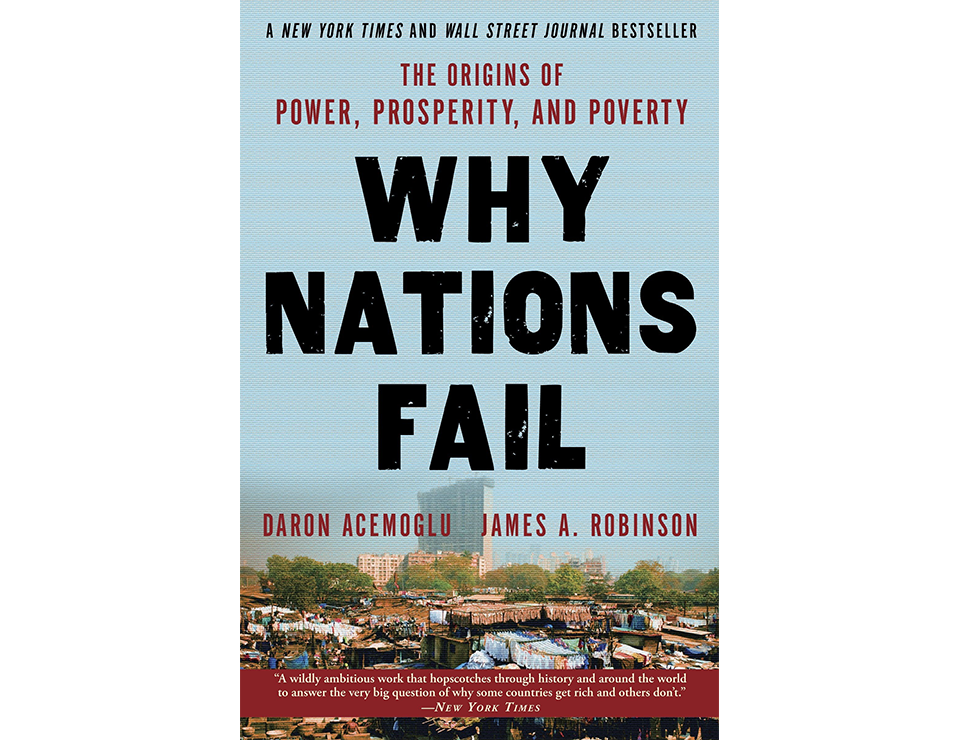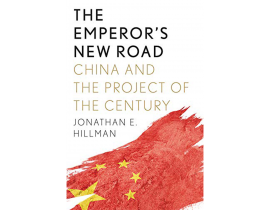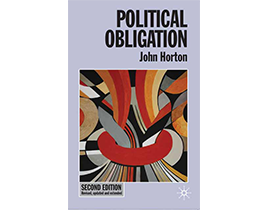Politicon.co
Why Nations Fail: The Origins of Power, Prosperity and Poverty

Book review
Daron Acemoğlu & James A. Robinson
Keywords:
Inclusive and extractive institutions, creative destruction, institutional drift, critical juncture, virtuous and vicious circles.
Introduction
World inequality has been one of the biggest problems throughout the last decades. Despite two centuries of rapid economic growth dynamics, more than a billion people remain in dire poverty, and the average income of the population of developed countries is dozens of times more than the countries like Zimbabwe, Sierra-Leone or Afghanistan. This particular global problem has attracted several scholars to deal with the “why?” and “how?” questions, as a result of which, different explanations have gained momentum since the last century. During the 1960s, the biggest attention was given to the lack of capital that would trigger economic growth in developing countries, and the major debate was between two dominant theories of the time:‘modernization’ and ‘underdevelopment’ theories. By the 1980s, concentration of disputes shifted towards economic policies of states and different conclusions were made, representing neoliberal and neo-statist economic schools. Consequently, these debates led international organizations such as the International Monetary Fund to recognize that poor development is caused by bad economic policies and institutions and propose a list of improvements (Washington Consensus) to be adopted by poor countries. However, many economies around the world implementing those reforms, mostly in Latin America, faced fierce stagnation during the 1980s and 1990s. While in theory, those reforms had to slow down inflation and trigger growth, this did not happen in reality, and hardly changed the way politics actually was being conducted in those countries. Central bank independence, for instance, – one of the key recommendations aimed at achieving macroeconomic stability, – did not work in the same way in Zimbabwe, Columbia, or Argentina as it had worked in developed nations. While the theories concentrating on economic reforms and institutions fail to explain why those countries did not manage to follow the paths of the developed ones, a Turkish-American economist Daron Acemoğlu from the Massachusetts Institute of Technology and political scientist James A.Robinson from Harvard University presented an alternative view in 2012 to answer this question – as well as explaining the different development paths of nations, with some achieving prosperity while others fail – by introducing the significant role of political processes and institutions, in their book “Why Nations Fail: The Origins of Power, Prosperity and Poverty”.
Summary
The authors agree that whether a country is poor or prosperous directly depends on economic institutions, whereas their main argument in the book is that it is politics and political institutions that ultimately determine what economic institutions a country has. In countries where political rights are much more broadly distributed in a pluralistic manner and where governments are accountable and responsive to citizens, political leaders tend to incentivize citizens to invest and innovate by guaranteeing private property rights and enforcing contract law. This kind of political institution, which is more conducive to economic growth, is characterized as ‘inclusive institutions’. Conversely, in countries where political power is in the hands of a narrow group of individuals, political institutions are shaped to maximize their power and eliminate their rivals, hence economic institutions are structured to extract resources from the citizens to the elite. This kind of ‘extractive institution’ is mostly against innovation in the economy, which is necessary for sustainable growth. The reason is that innovation leads to disruptive effects between the relations of the old and the new in the economic realms, ultimately destabilizing power relations in politics. The absence of these disruptive effects – ‘creative destruction’ in authors’ terms, – hinders economic development in most of the developing countries nowadays: “World inequality exists because during the nineteenth and twentieth centuries some nations were able to take advantage of the industrial revolution and the technologies and methods of organization that it brought while others were unable to do so” [p. 271].
So we have established that sustainable economic growth demands inclusive economic institutions encompassing property rights, contract enforcement and competitive markets, which, in turn, demand inclusive political institutions, which imply both the broad distribution of power and the limits to it, generally characterizing the pluralist system of governance. For these institutions to be established, however, the first necessary condition is the centralized state. In order to be able to enforce law and order, uphold property rights and encourage economic activity when necessary by investing in public services, some degree of political centrality is an unavoidable condition. By suggesting this, the authors refer to the states such as Somali, which remained in a particularly disadvantaged situation during the age of industrial revolution in the eighteenth and nineteenth centuries [p. 244].
By presenting the aforementioned stages that have to be reached to achieve prosperity, Acemoğlu and Robinson focus on the path-dependency of historical transformation. History is contingent, and a minor institutional difference in initial conditions caused by gentle ‘institutional drift’ makes a significant difference when a country faces a ‘critical juncture’, setting them on diametrically different paths. For instance, the fact that during the 14th-century landlords in Eastern Europe were a little more powerful and peasants less organized than the West, the Black Death led to the realization of the “butterfly effect”: while Western peasants struggled against serfdom and achieved its abolishment, serfdom in the East strengthened its roots as a result of the exact same process. The Black Death here represents the critical juncture – “a major event or confluence of factors disrupting the existing economic or political balance in the society”. The authors refer to this notion as a “double-edged sword that can cause a sharp turn in the trajectory of a nation: on the one hand, it can open the way for breaking the cycle of extractive institutions and enable more inclusive ones, as in the West, or it can intensify the emergence of extractive institutions, as was the case with the Second Serfdom in Eastern Europe” [p.101].
In fact, the notion of ‘critical juncture’ plays an important role from this theoretical perspective, as it is seen to be the only way to break the persistent nature of institutions. Once a society is organized in a particular way, those organizations tend to persist. If a change has led to the creation of inclusive political institutions, these institutions will support inclusive economic institutions, which in turn will encourage the establishment of more inclusive political institutions, – in a way creating a virtuous circle, a process of positive feedback, and increasing the chances of these institutions to persist and even expand [p.333]. Conversely, extractive political institutions generate few constraints on the exercise and the abuse of power, which lets the elite expropriate the assets of the others by setting up monopolies, – ultimately generating a vicious circle preventing the nations from following the path of sustainable development. Critical junctures, such as the Glorious Revolution in England or the Meiji Restoration in Japan can result in the destruction of vicious circles, however, in order for critical junctures to reverse the extractive path of societies, one condition is critical: a broad coalition of the population has to be empowered to replace absolutist institutions with more pluralistic ones. This point explains the major differences between the outcomes of revolutions in England and Japan on the one hand, and Sierra Leone and Ethiopia on the other: while former two countries created inclusive institutions, the ‘iron law of oligarchy’ let the following two maintain and even enforce the extractive institutions they had been having before [p. 365].
Critical points in the context of the broader discussion
Although inclusive institutions are presented in the book as the necessary precondition for sustainable development, Acemoğlu and Robinson also accept the possibility of achieving economic growth under extractive political institutions. Particularly two ways of extractive growth is presented by the authors: 1) elites directly allocating resources from less-efficient to high-productivity activities that they themselves control (Soviet Union`s 5-year plans since 1928); 2) elites permitting limited development of inclusive economic institutions, as in South Korea and China. In fact, the idea that extractive institutions can manage temporary economic growth is not a novel and is compatible with the ideas of other scholars. Rodrik, for example, asserts that growth requires only narrow range of policy reforms: “When a country is so far below its potential steady-state level of income, even moderate movements in the right direction can produce a big growth payoff”. Nevertheless, extractive growth, according to Acemoğlu and Robinson, does not translate into sustainable growth, simply because of a lack of creative destruction. By illustrating the Soviet example, the authors make implications about the future of China, that despite current impressive growth rates, this is only temporary for them. Chinese growth is based on the adoption of existing technologies and rapid investment, not creative destruction. Also stressing on the absence of entirely secure property rights in China, Acemoğlu and Robinson’s verdict for this country turns out to be far from positive. Rodrik too underlines the same point about China and emphasizes the need for an extensive range of institutional reforms from financial markets to political governance, in order to maintain sustainable growth rates. Although Rodrik slightly mentions the point of mass empowerment, the difference between him and the authors of ‘Why Nations Fail” is that Rodrik leans on the importance of institutional reforms, while Acemoğlu and Robinson do not see any other way than fundamental political change caused by critical juncture.
The second important point is about the objection of Acemoğlu and Robinson to the modernization theory, which has been largely popular within academic circles since the 1960s. Contrary to the ideas of Martin Lipset and his proponents, the authors of “Why Nations Fail” do not expect the authoritarian growth of China to lead to democracy or to any kind of inclusive political institutions. According to them, limits of growth will be reached before the transformation of political institutions in a more inclusive direction happens. Although no statistical evidence is provided in the book itself, Acemoğlu and Robinson rely on their previous researches, concluding in the book that there is, in fact, no causal relationship between economic growth and democratization, and ultimately discouraging the endorsement of authoritarian growth.
However, it is rather debatable why China cannot achieve transformation towards inclusive political institutions, while South Korea, previously being governed by extractive political institutions, has managed to do that. In order to answer this question, Acemoğlu and Robinson present several explanations, the first of which implies that economic institutions had become sufficiently inclusive by the 1970s that they reduced the incentives of the political elite to hold on power. Firstly, this suggestion creates some sense of ambiguity, as the authors do not indicate any concrete threshold that would help us differ between ‘sufficient’ and insufficient levels of inclusiveness of the institutions, which would determine the future trajectories of development. Secondly, while the main thesis of the book implies the prevalence of political institutions over economic ones, this point creates certain suspicions on the given thesis. Thirdly, while the main thesis is concerned with internal institutional factors, a key influence to the democratization process in South Korea is seen to be made by the U.S., according to the book. So it could be debated whether South Korea would have achieved or not political liberalization without the influence of the U.S. – the idea, which slightly undermines the role of inclusive institutions in determining the political outcome [93].
Although the main hypothesis of “Why Nations Fail” could be debated with other hypotheses, such as “geography”, “culture” and “ignorance” hypotheses, one of the most important points of the book is illustrated in the last chapter when pushing the limits of “ignorance” hypothesis. While Western policy-making circles still concentrate on the economic policies and institutions, as well as market failures of poor countries: they fail to recognize the role of political institutions and the constraints they place on policy-making, – they fail to recognize the root cause of the problems, which is extractive institutions and the politics that keeps them in place.
Conclusion
While economists, in an attempt to understand the economic failures of certain nations, focused mostly on economical factors, such as models and competition, what we inherit from Acemoğlu and Robinson is the significance of political processes in the distribution of economic resources: empower the broad mass of people, and property rights, contract enforcement and the freedom of choice will follow. Thus the solution to the economical failure of the nations today is to convert extractive institutions into inclusive ones. The concept of vicious circles implies that there is no easy way to do this. But if this is the exact problem to be dealt with, in order to tackle the world inequality, the “how?” question arises at this moment. While the authors make a hint towards the issues such as the role of media, and more efficient ways of distributing foreign aid in helping to cause mass empowerment process, this particular question demands more research for the sake of prosperity of the future generations.
References
- Acemoğlu, Daron, and James Robinson. 2012. Why Nations Fail: The Origins of Power, Prosperity, and Poverty. New York: Crown Business
- Daron Acemoğlu, Simon Johnson, James A. Robinson, Pierre Yared. 2008. Income and Democracy. American Review. 808-842.
- Philips, Nicola. 2014. “Globalization and Development” in Global Political Economy, ed. John Ravenhill. New York: Oxford University Press, 344-371.
- Rodrik, Dani. 2007. One economics, many recipes: globalization, institutions and economic growth. Princeton University Press.
- Seymour Martin Lipset. “Economic Development and Democracy. Chapter 11, in Lipset, Political Man: The Social
- Bases of Politics (New York: Doubleday). 46-76.
![]()
- TAGS :
- TOPICS :
- Economy
- Public policy
- Society









jpg-1599133320.jpg)

